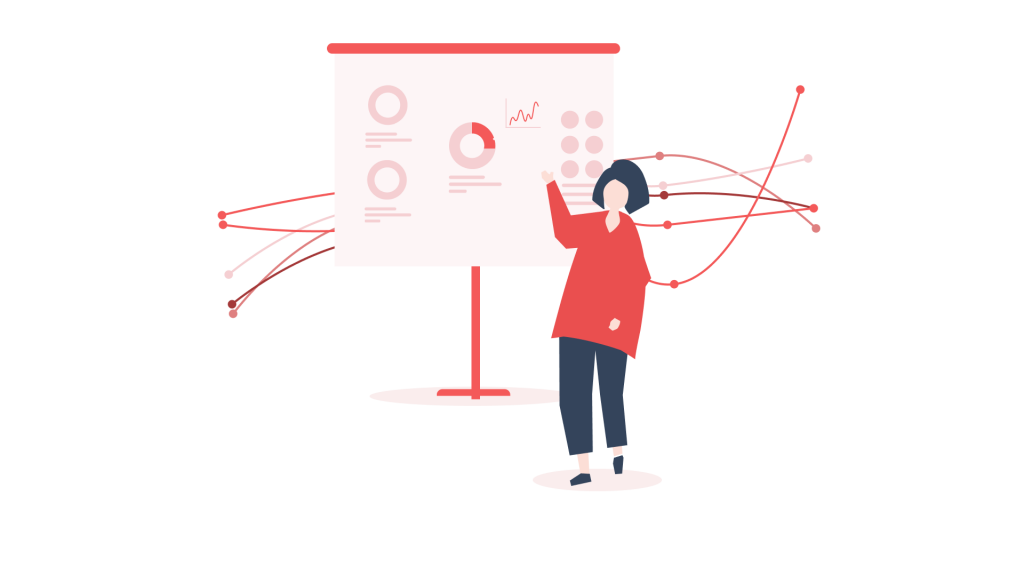Analyzes and measurable CPI – Creating an SEO strategy

To be able to see the fruits of your SEO labor and see the possibilities with optimization, there are several useful tools to use when analyzing and creating reports. Allow yourself the opportunity to create a sustainable strategy.
Useful services for Search Engine Optimization
There are several different tools available to facilitate your work with SEO. Here is a list of tools that can be useful as you go through your search engine optimization.
Free services from Google
Google Search Console
Google PageSpeed Insights
Google Web Vitals
Google for Retail
Google My Business
Premium services for SEO
SEMrush
Ahrefs
Moz Pro
KWFinder
Other useful services and plugins
Hemmingway Editor
Grammarly
Sucuris site check
Panguin tool
Yoast SEO
For you to be able to set goals with your search engine optimization and marketing, analyzing is a must. It is also beneficial as it gives you lots of useful insights to use in your strategy. You want to have clear goals to be able to measure the CPI.
Websites differ, and different businesses and websites require different strategies for their search engine optimization.
Measure the CPI for SEO and see how your website performs
To see how your search engine optimization works and to be able to set clear goals, you can use several data points for the CPI. It is about producing the right data for your business through the available tools. Several of these services can also be integrated to obtain even more specific data.
Organic traffic
This data point is about seeing how many visitors your site generates through organic search results. This is the clearest data you can produce. It is easy to see if you are reaching your goals with the number of visits your site receives.
One of the best tools for generating data (and statistics) on organic traffic is Google Analytics. In Analytics, go to Target group → Overview, add segments, and click on “Organic traffic” and press “Use”.
Now that you have loaded the statistics with data for organic results, you see how the organic traffic changes over time and how it correlates with the total traffic.
Ranking
How do your pages rank in the search results? It’s no secret that the higher you get in the results, the more traffic your site will get.
Search rankings are a crucial KPI benchmark for SEO because they directly correlate with how well you succeed with your optimization. When the higher rankings are reached, other goals will also be achieved more efficiently, such as your goals for traffic, potential customers, and conversions.
But it is also important to make sure that you rank using the right keywords. For example, if you rank on “Headphones, black” for a page with a pink microphone, that ranking will probably get worse over time. Using this search phrase, you want to rank for a page that actually contains “Headphones, black”.
To get ranking data with your keywords, you need to use one of the available SEO services. Some examples are SEMrush, Ahrefs, and Serpstat.
With tools like these, you will be able to see how your page ranks and how your ranking develops over time. You also have the opportunity to sneak peek on how your competitors rank in comparison to you.
Exposure
Search engine exposure shows how many times your site appears in the search results for the keywords it ranks with.
By researching your search engine exposure, you can get early indications of how your site is performing in the search results. In other words, it is an important key value to keep track of if you want to be at the forefront of your SEO.
To view exposure statistics for your site, use the Google Search Console.
You will find this report as “Total Exposures” under “Results” in the Search Console. Each time a user visits a search results page that contains your URL, an exposure will be recorded.
Inbound links
Links are a cornerstone of the Internet, as well as SEO. In other words, building links to your website is essential and should, therefore, be part of your SEO strategy.
But before you start a strategy for building links, there are a few things to keep in mind.
To begin with, you have to see the different values that different links have. For example, buying a lot of links from random pages completely irrelevant to yours will not help you optimize your page; rather, it will do quite the opposite.
What you do want to build are quality links. To keep track of your link portfolio and see what value the intended link building can have, we recommended you use some kind of analysis tool for SEO.
Some examples:
With these tools, you can get data on link quality, authority index for links, and much more.
Read more about Link Building and how to create a solid link portfolio.
Organic CTR
Clickthrough rate (CTR) is a metric that measures the relationship between clicks on your links and the total number of users who viewed the search results that contain your site. In other words, high CTR = more traffic.
CTR is also an important signal for search engine rankings. If your excerpts on search pages are not appealing enough, they will not generate any traffic, regardless of ranking. Low CTR sends the signal that “this is not a relevant page” to Google’s algorithms.
Many people fail to include the CPI for organic CTR. But by analyzing this data, you can make the necessary changes to increase your click through rate.
Use Google Search Console to create reports that you can work with.
Brand traffic
Trademark traffic is the traffic that comes through users searching for terms that contain your brand name. If brand awareness is important for your brand (and it should be), then brand traffic should be your primary CPI.
Since this type of search is performed by people who already know what they want to get out of the result, it is traffic with very high conversion.
Track this CPI using Google Search Console
- Add all occurrences of your brand name as a filter in the Search Console.
- Analyze how the number of clicks and exposures changes.
Bounce rate
This frequency is measured in what percentage of your visitors reject the site without taking any action.
The bounce rate is another important data point, and not only because it clearly affects your ranking. Depending on which market you belong to, the bounce rate should, on average, be between 40-60%. If the percentage is higher, it indicates that the pages are not relevant to the search.
Monitor the bounce rate of your site in your Google Analytics Summary Report to identify which pages result in high rates. Try different methods to see what can help you reduce it.
Average session duration
How much time do your visitors usually spend on your site? Is your content engaging enough to keep the visitor interested for a more extended period of time?
Viewing average session times on your website is an excellent tool to see just how well you engage the people who visit you. Do they stay and read the full articles or click through to other, more exciting content?
By monitoring the session time on your website, you will see indications of your pages’ quality and whether you may need to improve the structure or not.
To improve session times, you can create a more in-depth structure of your page by adding internal navigation (breadcrumbs), blocks for related content, and more internal links.
Cost per click
Unlike paid search advertising (SEM), you don’t pay for organic search results. However, in a way, these results still have their own costs.
Cost Per Organic Click (CPC) defines how much you pay per visitor through organic search results. You can calculate this cost by doing the following:
Your budget / Website traffic
“Your budget” is what you put into all the optimization for SEO, SEO experts, SEO services, copywriting, etc.
If your strategy is effective, this cost (CPC) will decrease for each month.
ROI
You can use ROI (Return On Investment) as a benchmark to research all your marketing campaigns. By calculating the ROI for SEO, you see if your net profit is worth the investment made for optimizing your website.
Calculate your ROI percentage:
Profit from investments – investment cost) / investment cost
Keep in mind that it is not at all uncommon to initially get a negative result. But with a successful and well thought out strategy, you will see positive results within a couple of months.
Find your data points to succeed with your strategy
Measuring all CPIs is rarely effective. Concentrate on measuring the CPIs that make a difference to your business and its goals. Here are some criteria you can use to choose which metrics you should use to analyze your SEO results and create your strategy.
- Specify your goals. What do you want to achieve? Be specific so you can measure your goals. If you want more visitors, then enter a specific goal, for example, 30% more visitors before the end of the year.
- Plan and set up a budget for search engine optimization of your website.
- Review which tools and services you need to use to be able to create a clear strategy and to be able to analyze your goals. Start with setting up Google Analytics and the Google Search Console. Then choose the appropriate premium service for SEO.
We can help you!
If you are a client of Angry Creative, you can prepare a strategy which we can help you implement on your website. Create a case and write down the points you have produced.
Final Tips
Finally, here are five quick tips that should be essential when working with your SEO and marketing your website.
- Learn as much as you can about SEO from several different sources. Do not miss our series of articles for search engine optimization in our knowledge bank.
- Keep up to date as a lot of changes occur both often and quickly. Google is constantly making changes that you want to keep up to date with.
- Have patience! Effective SEO requires hard work and time; nothing happens overnight. It’s worth it in the long run. Studies show that SEO is what gives the best ROI for inbound market channels.
- Avoid dubious methods at all costs. For example, buying inbound links can often be more expensive than investing in accepted SEO methods.
- Do not spam!
Good luck with your optimization!
Are you interested in learning more about how to optimize your website?
Don’t miss out on our other articles:
- Keyword Research – Rank Higher by Finding the Right Keyword.
- Off-Page SEO – Take advantage of opportunities outside of your website.
- On-Page SEO – Mastering the optimization of your website to increase conversion.
Are you ready to take your website to the next level?
We take responsibility for the operation, maintenance & management of WordPress & WooCommerce. We will assume responsibility from your previous provider and solve ongoing bugs and other problems that may arise. All for a fixed monthly budget.
You may also be interested in these articles
Brexit for WooCommerce sellers
The impact of Brexit is huge. There are very many implications for those in e-commerce businesses…
Read more
Brexit for WooCommerce sellers
Cynefin: a valuable framework to classify, communicate and respond to tasks in digital projects
Cynefin. At Angry Creative we think it’s a vital part of digital projects. It helps us to underst…
Read more
Cynefin: a valuable framework to classify, communicate and respond to tasks in digital projects
Web fonts for WordPress
Fonts control how your text is displayed – how the letters actually look. web-safe fonts. W…
Read more
Web fonts for WordPress
Subscribe to our newsletter for tips, inspiration and insight about WordPress and WooCommerce and the digital world beyond.
Time to take the next step towards a more effective website?
Contact us, and we can talk more about how we can take your business to the next level together.


